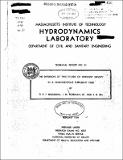| dc.description.abstract | Introduction: Industrial communities situated near large bodies of water or in drainage systems connected with such bodies dispose their waste water after treatment by dilution. Disposal by irrigation or evaporation after removing the solids by filtering, drying and incineration is justified in circumstances where the necessity outweighs the increased cost. However, comparatively few large industrial communities in the United States are situated away from either ocean, estuary, lake or river, so that the predominant form of ultimate waste water disposal is by dilution. In waste disposal by dilution a certain degree of primary treatment is usually required to reduce the concentrations of constituents that are toxic, odoriferous or otherwise chemically or physically detrimental or objectionable to human, animal or vegetable existence. Industrial and other wastes, varying widely in composition, coming from a diversity of establishments, such as dye or fertilizer factories, paper mills; primary treated sewage and supernatant liquor from digested sewage, radioactive waste products; wastes from hospitals, dairies, slaughter houses, etc., present different treatment problems and different standards for their effective disposal. After a sufficient time interval has elapsed following disposal, harmful chemicals will be oxidized to well below allowable levels, organic material digested by bacterial action, low level radioactive waste products; subjected to decay and a natural balance will be obtained. This can, however, be achieved only if the dilution process is aided by dispersion with currents due to winds and tidal action. Conversely, inadequate primary treatment or initial dilution can lead to widespread contamination by dispersion of harmful constituents endangering life. of property. The disposal of the water-borne waste products should be made in such, a fashion and at such regions in the body of water that tendencies for segregation of the influent will be minimized. The nature of the solution of this problem is twofold: (1) the achievement of optimum mixing characteristics with economical energy input at the disposal point, (2) the location of the disposal area in a region where hydrographic or oceanographic evidence indicates degrees of boundary shear, of wave and wind generated turbulence, and thermal or tidal convection currents that will continue the dispersion of the diluted effluent in order that concentrates would not tend to accumulate with passage of time or segregate into tidal backwaters or be absorbed by vegetation or soil on the shores. Allied problems, which have in most cases direct bearing on the flushing of disposal areas, are the salt water intrusion into river mouths and the fresh and salt water balance in tidal estuaries. Apart from the estuary flushing,there is also the consideration of contamination of public or industrial water supply intakes due to salinity intrusion. All of the problems mentioned above, in general terms, involve the mechanics of mass transfer according to the combined operation of turbulent diffusion and convection. Turbulent diffusion processes thus fall into two general categories. In the first, the turbulent diffusion is due entirely to the momentum of the diffusion which is being introduced into a quiescent diffusing medium: this process being governed by the mechanics of momentum and mass transfer in submerged turbulent jets. In the second category, the turbulent diffusion is due largely to the turbulent energy of the receiving fluid, the diffusion being introduced without materially increasing the turbulent activity at the region of introduction. In practice the ideal dilution process would be a combination of the two processes in the above sequence. The diffusing substance would be discharged with as high a momentum as practical into the receiving medium in the form of submerged jets, and the diffusion process in the vicinity of the disposal points would be entirely governed by the energy of introduction of the diffusion. At sufficiently large distances from its source the momentum of a jet would have decayed to levels comparable to the turbulence level in the receiving body of fluid. Further dispersion will occur according to mechanics of diffusion due to the turbulence in the receiving fluid body itself. (That is, if one considers momentarily turbulence as including all sizes of eddies present and hence also what would be customarily considered convection currents). The analysis will be simplified, however if it is considered that the motion of the fluid body consists of a field of homogeneous turbulence in which a convection pattern may be superimposed. With further simplification, the general problem may be made feasible for mathematical and experimental analysis in particular cases. Thus all of the above-enumerated disposal problems involve ultimately the mechanism of turbulent (eddy) diffusion which can accordingly be treated in two distinct parts. | en_US |
